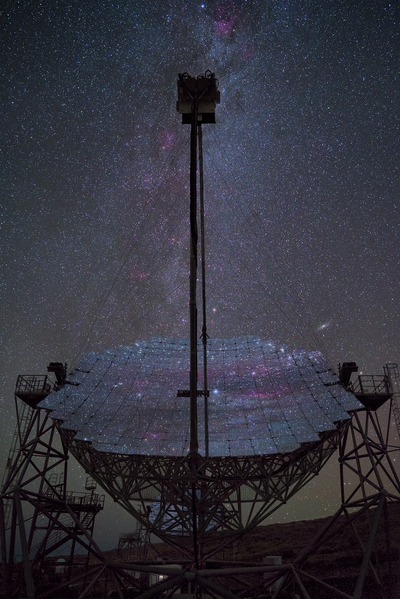
Interestingly, prof. dr hab. Włodzimierz Bednarek and dr hab. Julian Sitarek (prof. UL), who now participated in this discovery, had already proposed a theoretical model predicting this type and source of radiation emission eleven years earlier.
Scientists from Lodz, from the Department of Astrophysics at the Faculty of Physics and Applied Informatics of the University of Lodz who participated in this ground-breaking observation are working as part of the MAGIC (Major Atmospheric Gamma-ray Imaging Cherenkov Telescopes) project. Their discovery points to a new type of sources of very high energy particles in space, the importance of particles acceleration processes during outbursts of novae, as well as their participation in the creation of cosmic rays filling our Galaxy.
The results of the observations and their interpretation are described in a paper that has just been published in the prestigious journal Nature Astronomy. One of the main authors of the publication is dr hab. Julian Sitarek (prof. UL).
From a red giant to a white dwarf
A star's life begins with its formation from clumps of matter in huge clouds of gas. For massive stars, it ends in spectacular outbursts, during which their brightness becomes comparable to that of the host galaxy. However, the fate of stars of small masses, the size of our Sun, will be different. Over the next 5 billion years, the Sun will deplete its nuclear fuel reserves and distend itself, reaching the red giant phase. Then it will shrink to the size of the Earth, becoming a super-dense white dwarf.
The Sun is a single star, while in the Galaxy 1/3 of the stars are paired with other stars. A white dwarf in such a binary star system can pull material from its companion, the red giant, forming a layer of it on its surface. After exceeding a certain critical mass, a thermonuclear outburst takes place in the hydrogen layer of the white dwarf.
The heated matter is ejected into space at thousands of kilometres per second and flares with a brightness of up to 100,000 times that of a typical Sun-like star. This is best seen in the animation from the source superbossa.com/MPP. Such a star suddenly becomes visible in the night sky even from a distance of thousands of light years. Historically, these objects were called "stella nova" – the new stars.
RS Ophiuchi – the outburst and gamma rays
The RS Ophiuchi in the Ophiuchus is a recurrent nova that erupts every dozen or so years. Its another outburst was observed on Earth on 8 August 2021, first by optical telescopes. Over the next few hours, the Large Area Telescope aboard the Fermi satellite also recorded gamma rays from RS Ophiuchi.
These observations resulted in the directing towards it the Cherenkov telescopes – H.E.S.S. in Namibia and MAGIC in the Canary Islands and the discovery of gamma emission with photon energies up to several dozen times higher than those observed by Fermi. Observations by the use of the MAGIC telescopes have allowed for detection of radiation that is hundreds of billions of times more energetic than visible radiation. They also made it possible to characterise the emission from the recurrent nova RS Ophiuchi just 24 hours after its outburst.
By combining data obtained from the MAGIC telescopes with observations at lower energies, a group of scientists cooperating as part of MAGIC project have shown for the first time that gamma rays from novae are produced as a result of proton acceleration to hundreds of gigaelectronvolts in the nova shock.
Secrets of the recurrent novae
Only a fraction of the protons loses their energy by producing gamma rays. Most of it escapes to interstellar space. Contribution of the outburst of RS Ophiuchi to the average galactic cosmic rays is small. It represents only a fraction of that which comes from their more violent cousins, supernovae, ending their lives in a single but order of magnitude more energetic outburst. However, in the case of recurrent novae, protons accelerated in subsequent outbursts will accumulate, forming bubbles around them of enhanced cosmic ray density.
Although the analysis of emissions from RS Ophiuchi has yielded the first convincing evidence of the origin of gamma rays from novae, a number of questions about the nature of these objects remains unanswered. We still do not know whether the emission of this radiation requires the presence of a red giant in a stellar system with a white dwarf, or whether it is a more universal phenomenon, also found in other types of novae (e.g., classic novae containing a star of our Sun type).
Scientists from Lodz hope that observations by the use of Cherenkov telescopes in the coming years will also allow for obtaining an answer to this question.
Edit: Promotion Centre of the University of Lodz
